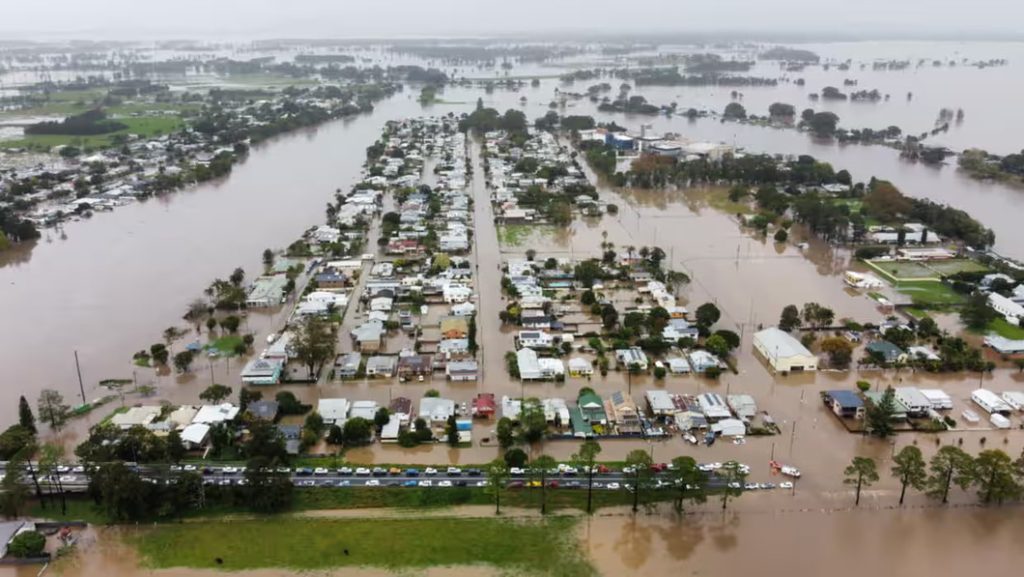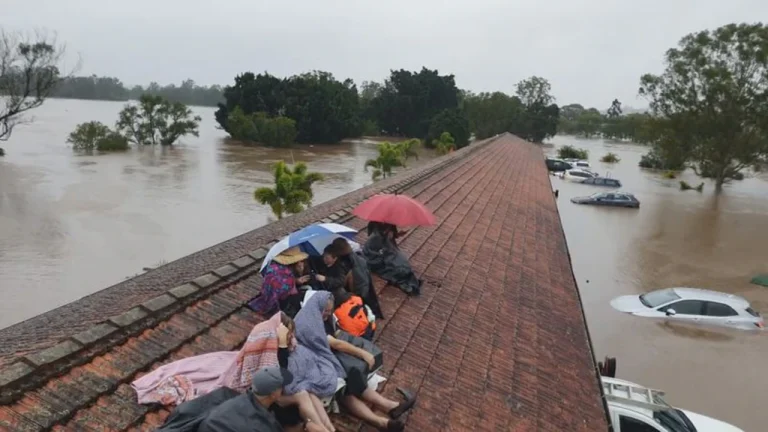One man has been confirmed dead and authorities fear for the safety of three others still missing amid severe flooding on the mid-north coast of New South Wales.
Premier Chris Minns described the past two days as “extremely challenging” and warned that more hardship lies ahead, with another 100mm of rain forecast in the next day and up to 300mm possible in isolated pockets.
“We’re increasingly facing these events more often, and sadly, we’re becoming more familiar with disasters like this,” Minns said on Thursday.
NSW Police reported that the body of a 63-year-old man was discovered on Wednesday afternoon at a flood-impacted property on North Moto Road in Moto. A report will be prepared for the coroner. Acting Police Commissioner Peter Thurtell said three others had been reported missing: a 60-year-old woman near Dorrigo, a 25-year-old man in the Wauchope area believed to have driven into floodwaters, and a 49-year-old man who may have walked into flooded terrain.
“These reports are still being investigated, and their situations haven’t been fully confirmed,” Thurtell said.
“Nonetheless, we are gravely concerned for all three individuals,” he added.
Minns extended his condolences to the loved ones of the deceased and said the community would need time to grieve and recover.
“I also have to prepare people for the likelihood of more tragic news in the coming hours. This disaster has taken a heavy toll on this region,” the premier said.
NSW Floods: Areas Facing Current or Potential Flooding and Severe Weather
This map highlights regions across New South Wales currently experiencing or at risk of flooding and storms. Although the map is regularly updated, it is not live—please refer to official NSW warnings for the most current alerts. Data accurate as of 1pm, 22 May.
Premier Chris Minns stated that around 50,000 residents are in areas under evacuation readiness alerts, with the potential to become cut off due to rising waters.
Within those zones, approximately 9,500 properties fall directly under active warning areas.
NSW State Emergency Service (SES) Commissioner Mike Wassing confirmed that as of Thursday morning, 145 flood alerts had been issued, 34 of which were classified as emergency-level warnings.
He said emergency teams were concentrating their efforts on flood-affected areas stretching from Taree to Coffs Harbour, including the towns of Port Macquarie, Kempsey, and Bellingen—all experiencing ongoing flooding.
“The best way the public can support us is by listening to the warnings: relocate early and evacuate when told, provided it’s safe to do so,” Wassing urged.
Emergency Services Minister Jihad Dib noted that the region is witnessing record-breaking rainfall and flooding along the mid and north coast.
He said that over 2,500 emergency personnel—among them 2,200 SES members—are actively assisting communities impacted by the disaster.
Severe rainfall is forecast to continue across the mid-north and northern parts of NSW through Friday morning, with intense, localized downpours expected to worsen conditions for people already cut off by the flooding.

Severe Weather Expands Across NSW as Record Flooding Hits Manning River
A severe weather alert was issued by the Bureau of Meteorology (BoM) early Thursday morning, broadening the affected area beyond the already flood-ravaged Hunter Valley and mid-north coast. The warning now includes the northern tablelands, northern rivers, and the north-west slopes and plains.
“Intense rainfall is expected to continue throughout Thursday as a weak low-pressure system develops within the trough and slowly tracks south,” the BoM said.
Heavy rainfall persisted across northeastern NSW overnight and into Thursday, with some areas forecast to receive up to 300mm over a 24-hour period.
Conditions have made rescue efforts extremely hazardous, said State Emergency Service Commissioner Mike Wassing. “People must take evacuation warnings seriously. I can’t promise that rescue crews will be able to reach everyone in time.”
To support displaced residents, evacuation centres have been established in several towns including Dungog, Gloucester, Taree, Manning Point, Wingham, Bulahdelah, Tuncurry Beach, Kempsey, and Port Macquarie.
In Taree, local doctor Helen Holliday described the impact of flooding on her medical practice. Cut off by road closures, she and her husband were unable to assess the damage. “We did what we could—sandbagged the place—but the power had to be shut off, and all our vaccines are lost,” she said.
With systems offline, doctors were unable to treat patients. “It’s heartbreaking when the community needs you and you can’t help. People are under so much stress,” Holliday added.
She said many local businesses had evacuated by Tuesday night, moving stock to higher ground. Some cafes that had been offering free meals to flood victims were themselves inundated.
Suburbs like Taree South and Purfleet were hit especially hard. “It’s a disaster zone,” Holliday said. “Everyone in town knows someone who’s lost everything.”
She warned that such events reflect a growing crisis. “What will it take for people to recognise we’re in a climate emergency? We have to take action—these events are going to become more frequent across Australia.”
On Wednesday, the Manning River exceeded its previous record flood level set in 1929.
Andrew Gissing, CEO of Natural Hazards Research Australia, said the flooding event along the river had an estimated one-in-500-year likelihood. “While it’s too early to determine the exact role of climate change in this particular event, we know a warmer climate holds more moisture, making extreme rainfall more probable,” he explained.
Evacuation centres have been opened at the following locations:
- Dungog RSL Club
- Club Gloucester
- Club Taree
- Manning Point Bowling Club
- Wingham RSL
- Bulahdelah Golf Club
- Tuncurry Beach Bowling Club
- Kempsey Showground
- Panthers Port Macquarie
Federal Emergency Management Minister Kristy McBain announced that disaster recovery payments had been activated for the council areas of Kempsey, Port Macquarie, Dungog, and MidCoast.
McBain echoed warnings about a changing climate. “We’re not talking about yearly events anymore—some communities are now experiencing disasters month after month,” she said.
With contributions from Australian Associated Press.

